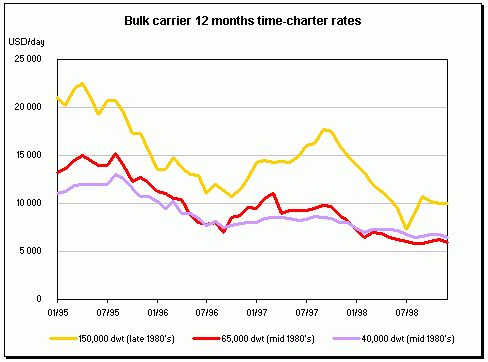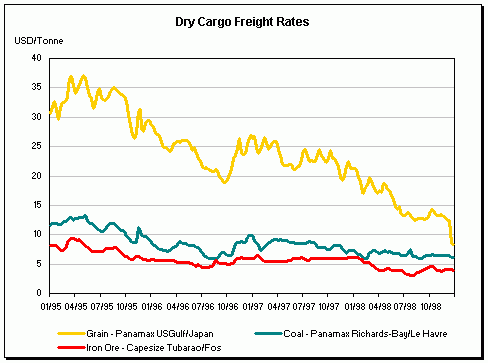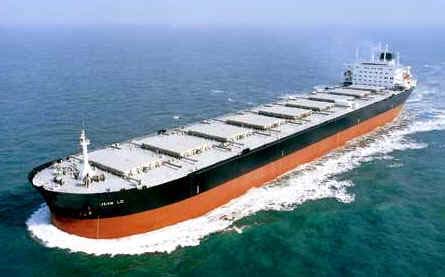The Dry Bulk Shipping Market in 1998
Although the Western economies maintained good growth rates in 1998,
sustained by high domestic consumption and a reduction in interest rates, the year has
confirmed the fears expressed in 1997 that the upheavals in the Asian economies would
cause turmoil in the shipping industry. There is no doubt that the crisis surprised many
by its magnitude and its suddenness.
1998 has been a difficult year for all bulk carrier shipowners and
operators, as shown by the fall in the BFI (Baltic Freight Index) from 1,232 to 780 and
that in the Handy index from 933 to 724.
With the economic crisis spreading to Russia and Brazil, after tipping
the Far-Eastern tigers, particularly Japan, into recession, the growth forecasts for world
trade in 1998 published by the World Trade Organization were between 4% and 5%, compared
with a record growth rate of 10% in 1997. The trend seems to be similar for world seaborne
trade.
The beginning of the year was marked by a continued fall in freight
rates, a trend which started in August 1997. Despite the traditional seasonal improvement
in April-May, mainly linked to grain releases, the downward trend was resumed until
September. The rates then steadied, as some shipowners decided to lay ships up, a measure
that had not been considered since the major crisis in the 1980s. There was an improvement
lasting until October, but the year closed with a general weakening and a predominantly
pessimistic feeling for the coming year.
The major event of 1998 in dry bulk transport was the reversal in rates
(shown in the analysis by ship size below) on Atlantic / Pacific routings, due to the
reduction in imports of raw materials by Asian countries while the Western economies, and
in particular the steel industry, were operating at full capacity. The devaluation of the
currencies of the Pacific zone countries accentuated this trade reversal phenomenon, with
increased exports of raw materials and steel to Europe and the United States. Conversely,
steel exports from Europe to Asia have fallen drastically.
In this context, the tonnage supply has been only very slightly modified
in deadweight terms, except for the Capesize class which ends the year with a substantial
negative balance between delivered and scrapped vessels.
Six months after the ISM Code came into force, it appears that the
repercussions on shipping rates have been practically non-existent, in contrast to the
hopes held by certain shipowners. Overall, the shipowners took the necessary measures to
make their ships conform to the Code ahead of its introduction. Only 5.1% of the ships
inspected within the first three months of application of the ISM Code by the 18 signatory
countries of the Paris MoU were finally detained.
The impact of the regulations is difficult to assess. It is worth asking
whether they have amplified the laying-up and scrapping of the oldest vessels.
Company restructuring, a trend initiated in 1997, has continued: P&O
merging its fleet with Shougang, NYK with Showa, Mitsui OSK Lines with Navix. Shipowners
are looking for economies of scale to offset the depression in freight rates.
The charterers, experiencing still greater competition in their sector
and not being able to further increase their margins by reducing internal costs, are also
looking for economies of scale through mergers and acquisitions, for example the purchase
of Cockerill by Usinor, the merger of Thyssen and Krupp, and the acquisitions of
Continental Grain by Cargill, Alumax by Alcoa and Minorco and Amcoal by Anglo-American.
The Capesize market
There is no doubt that the Capesize market has experienced the largest
decrease, despite the sustained iron ore and steam coal imports into Europe.
A quick look at the rates shows that in general the decrease is
approximately 30%. For example, the one-year time-charter rate for a CSBC-class ship
dropped from US$15,000 at the end of 1997 to $10,000 at the end of 1998. Similarly, the
Hampton Roads / Dunkirk spot rate for 110,000 tonnes of coal fell from $7.25 to $4.5. The
Tubarao / Fos rate for 150,000 tonnes of ore dropped from $6.15 to $4 per tonne.


Shipowners operating their ships on the spot market suffered more than
those having a good level of contract coverage, the latter thus being able to use their
own fleets and obtain better optimization according to the market. In the absence of a
shared point of view on the development of the market and, consequently, in the absence of
agreement between shipowners and charterers on the freight rates for medium-and long-term
contracts, the charterers have tended to keep their cargoes for the spot market, thus
avoiding the need to accept excessively high contractual freight rates as in the past.
A certain number of current contracts have been revised to introduce
indexing with respect to market rates.
These two trends could result in greater sensitivity and nervousness of
the market in the coming year.
Whereas in 1998 the shipowners tended to give priority to more complete
coverage of their fleets by current contracts, in 1999 they will have to improve the
optimization of their vessels.
Forward markets could then become more important tools for limiting the
freight rate risk.
Within an overall downward trend in raw material prices of between 10
and 20%, the Australian coal and ore producers and the Indonesians, helped by the
devaluation of their currency, have increased their sales, particularly in Europe, leading
to an increase in the number of open Capesize in the Atlantic.
The European metallurgical industries were working at full production
capacity during the first nine months of the year, thus preventing the market from
plunging lower. However, steel production is tending to fall under the combined effects of
the anticipated reduction in growth and massive steel imports from the Far East.
Coal imports into Europe, and mainly into France, then took over, but
their increase is more of an epiphenomenon than a firm trend.
Finally, the drop in the price of bunker oil has certainly softened the
consequences of the crisis and the fall in freight rates.
The Capesize category was the only one whose tonnage decreased
significantly in 1998, 43 ships having been scrapped since the beginning of the year, a
total of 5,829,246 dwt, compared with 15 ships totaling 2,258,625 dwt delivered.
 |
Jean LD 165,133 dwt,
built 1993 by Gdynia,
owned by Louis-Dreyfus Armateurs |
|